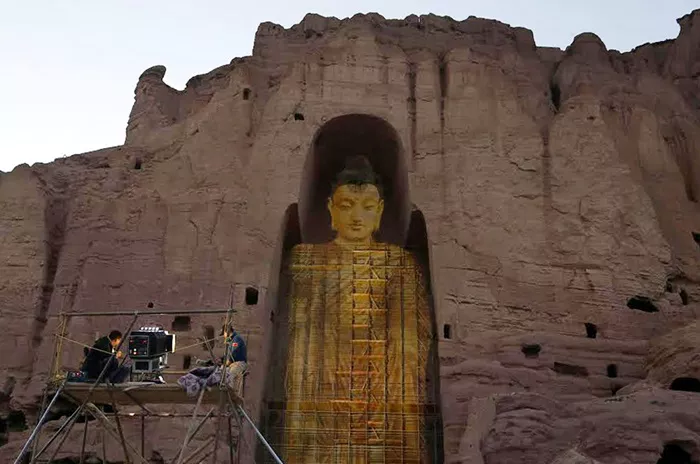The Buddhas of Bamiyan were two giant statues carved into a cliff in the Bamiyan Valley of central Afghanistan. They stood as symbols of ancient Buddhist art and culture for over 1,500 years. These statues were famous not only for their size but also for their spiritual meaning and artistic beauty.
Today, their story teaches us about the power of faith, history, and the importance of cultural preservation.
The Historical Background of the Buddhas of Bamiyan
Origins and Construction
The Buddhas were built around the 6th century CE during the Kushan Empire, a time when Buddhism spread widely in Central Asia. The larger statue stood about 55 meters tall, and the smaller one was around 38 meters. Both were carved directly into the sandstone cliffs.
These statues represented the standing Buddha, symbolizing peace, compassion, and enlightenment. Around them, there were many caves used by Buddhist monks as meditation and living spaces, making the site a spiritual center.
Significance in the Buddhist World
The Buddhas of Bamiyan were an important stop on the Silk Road, the ancient trade route connecting the East and West. They were admired by travelers and pilgrims from many countries, helping spread Buddhist teachings and culture.
They also showed a unique blend of artistic styles, mixing Indian, Hellenistic, and local influences. This blend is a fine example of buddhist architecture.
The Cultural and Religious Importance
Spiritual Meaning
For Buddhists, the statues were more than just art; they were sacred images representing the Buddha’s presence on earth. They inspired faith and devotion, encouraging people to follow the Buddha’s teachings of kindness, mindfulness, and wisdom.
The surrounding caves served as monasteries and meditation halls, supporting the spiritual life of many monks and pilgrims over centuries.
Symbol of Peace and Unity
The Buddhas stood as symbols of harmony in a region with many different cultures and religions. They reminded people of the Buddhist values of peace and compassion, which are central to all traditions of Buddhism.
The Destruction of the Buddhas
Events Leading to the Destruction
In March 2001, the Taliban regime ordered the destruction of the Buddhas of Bamiyan. They claimed the statues were idols, which they believed went against their strict interpretation of Islam.
This act shocked the world because the statues were irreplaceable cultural treasures and an important link to the Buddhist past of the region.
Methods of Destruction
The statues were destroyed using explosives and artillery over several weeks. Despite international pleas to preserve them, the Taliban carried out the demolition completely, leaving only empty niches in the cliffs.
Aftermath and Global Reaction
International Outcry
The destruction sparked global condemnation. UNESCO and many cultural organizations called it a tragic loss for humanity. The event highlighted the need to protect cultural heritage, especially in times of conflict.
Efforts to Preserve Memory
Since then, many efforts have been made to preserve the site and remember the Buddhas. Scholars and artists have worked on digital reconstructions, and discussions continue about possible restoration.
The site remains a UNESCO World Heritage Site, reminding us of the importance of respect and protection for ancient temple architecture around the world.
Cultural Significance Today
Symbol of Resilience and Hope
Though destroyed, the Buddhas of Bamiyan continue to inspire people worldwide. They symbolize resilience—the idea that spiritual and cultural values can survive even after physical destruction.
Many Buddhists see the story as a reminder of impermanence, a key Buddhist teaching that all things change and nothing lasts forever.
Educational and Spiritual Legacy
The site still attracts scholars, tourists, and Buddhist practitioners. It offers lessons about coexistence, history, and the spread of Buddhist philosophy. The Buddhas’ story encourages respect for diversity and the protection of cultural treasures.
Conclusion
The Buddhas of Bamiyan were not only remarkable works of Buddhist art and architecture but also powerful symbols of peace, spirituality, and cultural exchange. Their tragic destruction remains a solemn warning about intolerance and loss.
Today, their legacy lives on in the hearts of Buddhists and people worldwide. They remind us of the need to cherish and protect all cultural and religious heritage as treasures of humanity.

